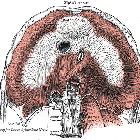Zwerchfell






The diaphragm is the dome-shaped muscle that separates the thoracic cavity from the abdominal cavity, enclosing the inferior thoracic aperture.
Terminology
On chest imaging, in particular chest radiography, an imaginary anteroposterior halfway line divides the diaphragm into two, forming the left and right hemidiaphragms.
Gross anatomy
The muscular fibers of the diaphragm originate around the circumference of the inferior thorax and converge to a common insertion point of the central tendon.
The muscle slips can be grouped according to their origins:
- sternal: arise from two strips under the xiphoid process
- costal: arise from the inner surfaces of the lower six costal cartilages and adjoining ribs, interdigitating with the transversus abdominis muscle
- lumbar: arise from the aponeurotic arches (lumbocostal arches) and from the lumbar vertebrae (crura)
There are two paired tendinous lumbocostal arches:
- medial lumbocostal arch (medial arcuate ligament): a tendinous arch from the superior anterior thickened psoas major fascia; continuous medially with the ipsilateral crus; attached to the L1/L2 anterolateral vertebral body, and the anterior aspect of the L1 transverse process
- lateral lumbocostal arch (lateral arcuate ligament): covers quadratus lumborum muscle; attaches medially to the L1 transverse process and attaches laterally to the tip of the 12 rib; this may be discontinuous on CT in up to 11% of people and hence may mimic diaphragmatic rupture
The crura are tendinous structures that blend with the anterior longitudinal ligament of the vertebral column:
- right crus is longer and broader than the left, and arises from the anterior surfaces of the bodies of L1-3
- left crus arises from the corresponding portions of L1-2
The medial margins of the two crura pass forwards and medially. They meet in the midline to form an arch in front of the aorta called the median arcuate ligament.
All these muscles insert into the central tendon, a thin but strong aponeurosis. It is situated immediately below and is fused to the pericardium. It is within this central tendon that the vena caval hiatus is located, with the tendon allowing the inferior vena cava (IVC) to remain patent during respiration.
Through the diaphragm are a series of 3 major and some minor apertures that permit the passage of structures between the thoracic and abdominal cavities:
- aortic hiatus (T12 level):
- aorta, thoracic duct, azygos vein
- esophageal hiatus (T10 level):
- formed mainly by the large right crus and its muscular fibers, phrenoesophageal ligament controls the hiatus
- esophagus, vagus nerves, small esophageal branches of the left gastric artery
- vena caval hiatus (T8 level):
- junction of the right and middle leaflets of the central tendon
- inferior vena cava, right phrenic nerve
- lesser apertures:
- two in the right crus - transmits the greater and lesser splanchnic nerves
- three in the left crus - transmits the greater and lesser splanchnic nerves, and also hemiazygos vein
- under the medial arcuate ligament: sympathetic trunks
- under the lateral arcuate ligament: subcostal nerves and vessels
- left phrenic nerve pierces the dome of the left hemidiaphragm
- sternocostal foramina:
- small defect between the sternal and costal slips of muscles
- superior epigastric vessels course through this area
The vertebral levels of the three main diaphragmatic apertures can be remembered by this mnemonic.
Arterial supply
- costal margins: lower five intercostal arteries; subcostal arteries
- abdominal surface: right and left inferior phrenic arteries (from abdominal aorta)
- supply is augmented by the superior phrenic artery and musculophrenic artery
Venous drainage
- right inferior phrenic vein into the inferior vena cava (IVC)
- left inferior phrenic vein into the left suprarenal vein or left renal vein
Innervation
- each phrenic nerve (C3-C5) supplies the ipsilateral hemidiaphragm with motor fibers
- lower intercostal nerves supply proprioceptive fibers to the margins
Movement
- major role of the diaphragm is inspiratory, but it is also used in abdominal straining
Variant anatomy
- muscle slips
- scalloped or serrated appearance: due to individual muscle slips
- dromedary diaphragm (hump)
- accessory diaphragm
- connection with transversus abdominis muscle
- sternal portion of the diaphragm may be absent
- extension of muscle fibers onto the quadratus lumborum muscle
- hemiazygos vein may run through the aortic hiatus
- azygos vein may run through the right crus
Development
The diaphragm embryologically develops from four main sources:
- septum transversum
- produces most of the central tendon and contributes to the ventral mesentery in the gut
- cervical myotomes (3 to 5):
- infiltrates the septum transversum with muscle cells
- carries their own nerve supply from these levels explaining the C3,4,5 origin of the phrenic nerve
- pleuroperitoneal membrane
- mesodermal folds which connect the septum transversum to the pericardioperitoneal canals
- separates the peritoneal and pleuropericardial cavities
- dorsal esophageal mesentery
Related pathology
Siehe auch:
- Zwerchfellhochstand
- Zwerchfellbuckel
- Aorta
- Perikard
- Zwerchfellhernie
- vena caval foramen
- Bauchhöhle
- Hiatus aorticus
- kongenitale Zwerchfellhernie
- Zwerchfellruptur
- einseitige Phrenikuslähmung
- oesophageal hiatus
- diaphragmatic breathing
- lesser apertures
und weiter:

 Assoziationen und Differentialdiagnosen zu Zwerchfell:
Assoziationen und Differentialdiagnosen zu Zwerchfell:






